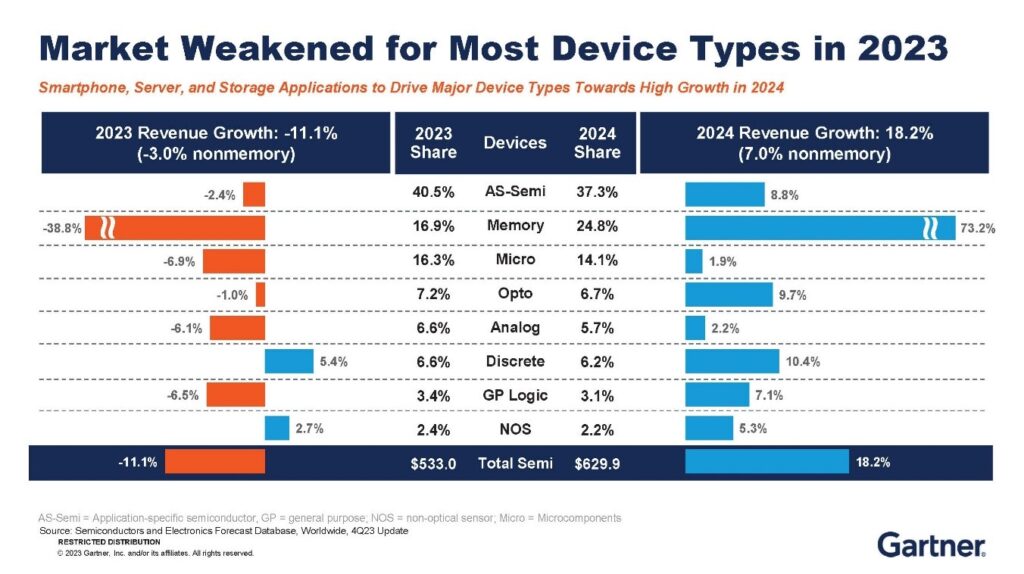Semiconductor Insights from the 2024 SEMI Industry Strategy Symposium

Every year, the SEMI Industry Strategy Symposium serves as a pivotal gathering for global leaders in the semiconductor sector to deliberate on industry performance, economic projections, and strategies for advancement. As we delved into the new year, we engaged deeply with the perspectives and knowledge imparted by industry luminaries at the symposium. Here, we present the pivotal insights gleaned from our participation:
Sustained Growth in Semiconductor Market
The relentless march towards newer, faster, and more advanced technologies propels the global demand for semiconductors, often dubbed as the “brains of modern electronics”. Forecasts indicate a remarkable surge in the worldwide semiconductor market, poised to exceed $633 billion, marking a growth rate surpassing 20% in 2024. Notably, experts have set their sights on reaching the trillion-dollar revenue milestone by 2023.

(Source: Gartner)
Meeting such ambitious projections necessitates the attraction and retention of a skilled and diverse workforce. Semiconductor companies must lay the groundwork for sustainable talent pipelines to ensure a steady supply of resources for the industry’s long-term viability.
Navigating Economic Realities
Despite the U.S. economy’s resilience in 2023, the outlook for 2024 portends sluggish growth amid persisting inflationary pressures and elevated interest rates. Europe anticipates flat economic expansion, while China eyes a more optimistic 5% growth trajectory, albeit with potential challenges.
Compounded by rising labor costs in the U.S., semiconductor companies must adapt to these economic dynamics. However, amidst these challenges, the industry is poised for a cyclical recovery, with multi-year growth anticipated. Key drivers include the burgeoning demand for semiconductors in high-performance computing, artificial intelligence, 5G infrastructure, and automotive and industrial technologies.
Fostering Tomorrow’s Semiconductor Workforce
A critical impediment facing the semiconductor industry is the imperative to cultivate and retain talent. Insights gleaned from industry executives underscored labor shortages as a primary concern for 2024. To tackle this challenge head-on, industry stakeholders must embrace a multifaceted approach:
– Initiating STEM programs and partnerships to nurture engineering talent from high schools through to universities.
– Recognizing the continued relevance of design, engineering, and creative skills alongside automation.
– Encouraging talent migration to semiconductor hubs, including rural areas hosting fabrication plants.
– Embracing a global perspective on talent acquisition to leverage diverse skill sets.
Prioritizing Semiconductor Sustainability
The semiconductor sector grapples with mounting environmental and energy-related challenges. Escalating manufacturing demands amplify energy consumption, prompting a shift towards self-sufficiency among fabrication plants through renewable energy initiatives.
Anticipating regulatory scrutiny, particularly regarding fluoropolymers, semiconductor manufacturers are bracing for potential policy changes impacting production processes. Proactive measures are underway to enhance energy efficiency through innovative technologies like chiplets.
Navigating Geopolitical Dynamics
Geopolitical tensions, notably between the U.S. and China, underscore the strategic importance of bolstering domestic semiconductor capabilities. Legislative initiatives, such as the CHIPS Act, aim to fortify the U.S. semiconductor industry’s competitiveness while imposing restrictions on technology transfers to China.
State-Level Initiatives

(Source: McKinsey & Company)
Several U.S. states are spearheading initiatives to bolster semiconductor infrastructure and incentivize industry growth. From innovation funds to tax credits, states like Texas, Arizona, Oregon, California, New York, and Michigan are positioning themselves as attractive destinations for semiconductor investments.
In Conclusion
The semiconductor industry stands at the nexus of technological innovation and economic growth. While demand surges, the industry faces multifaceted challenges, chief among them being workforce development. Collaborative efforts between industry players and seasoned talent acquisition partners like intiGrow Staffing are paramount to overcoming these obstacles and ensuring sustained growth in 2024 and beyond. Reach out to us to explore how we can support your semiconductor hiring needs.





